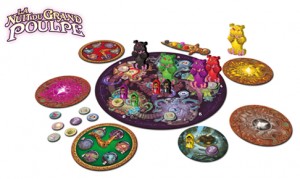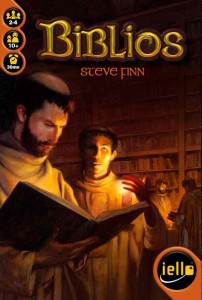Spiel 2014 Preview: Night of the Grand Octopus
Posted by James (admin) on 1st October 2014
 Night of the Grand Octopus is a game of second-guessing and double-think your opponents, with Cthulhoid overtones, as you try to be the cult that summons the great tentacled one. The first player to gather all of the required items to perform the summoning rite wins.
Night of the Grand Octopus is a game of second-guessing and double-think your opponents, with Cthulhoid overtones, as you try to be the cult that summons the great tentacled one. The first player to gather all of the required items to perform the summoning rite wins.
Each player has two tokens – one represents your cultists and the other represents your monster. Each turn, players set, and then simultaneously reveal, the locations where each of their tokens is going to move to. Monsters can move anywhere, but cultists can only move to one location one space from their current location.
Each locations starts with items that the players are trying to collect. If one cultist token is on a location with no monsters, they can take one of the items. However, if there are cultists and monsters on a location, the cultists gain nothing and a fight breaks out with all players involved losing 1 cult power. If there are multiple cultists but no monsters, the player must agree to all take nothing, or agree which single player will take an item; if they can’t agree, a fight breaks out and all players lose 1 cult power.
As well as the main locations, the game is played with 1 of the 4 external locations which players can move to instead fora special effect. I like that the rules explain what effect on the game each of these external locations will have, i.e. longer, more tactical, etc. Read the rest of this entry »
Tags: board game news, Board Games, board gaming, Essen, Iello, Night of the Grand Octopus, Spiel 14, Spiel 2014, Superlude
Posted in Board Games, Essen Spiel 14, Night of the Grand Octopus, Preview, Spiel 2014 | No Comments »


